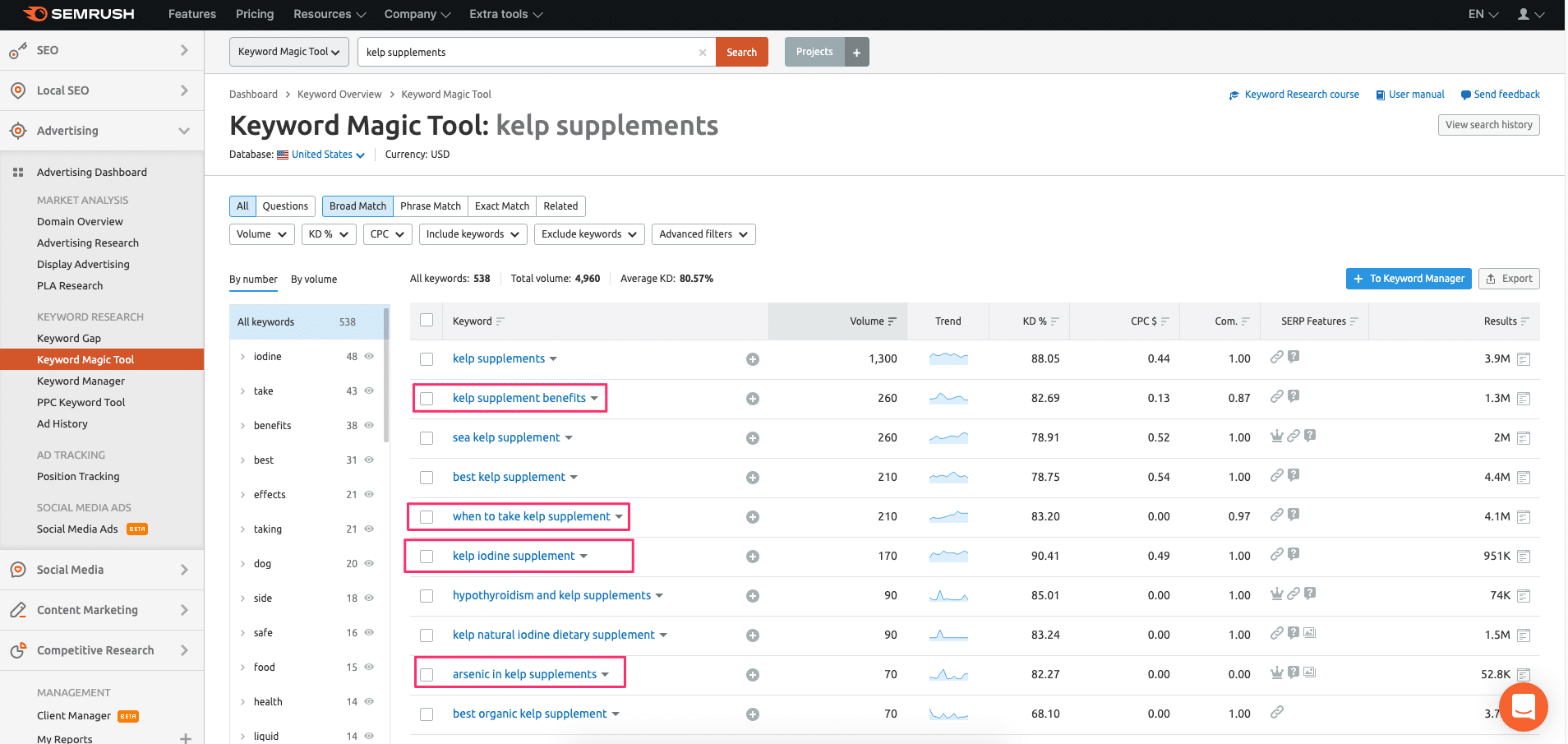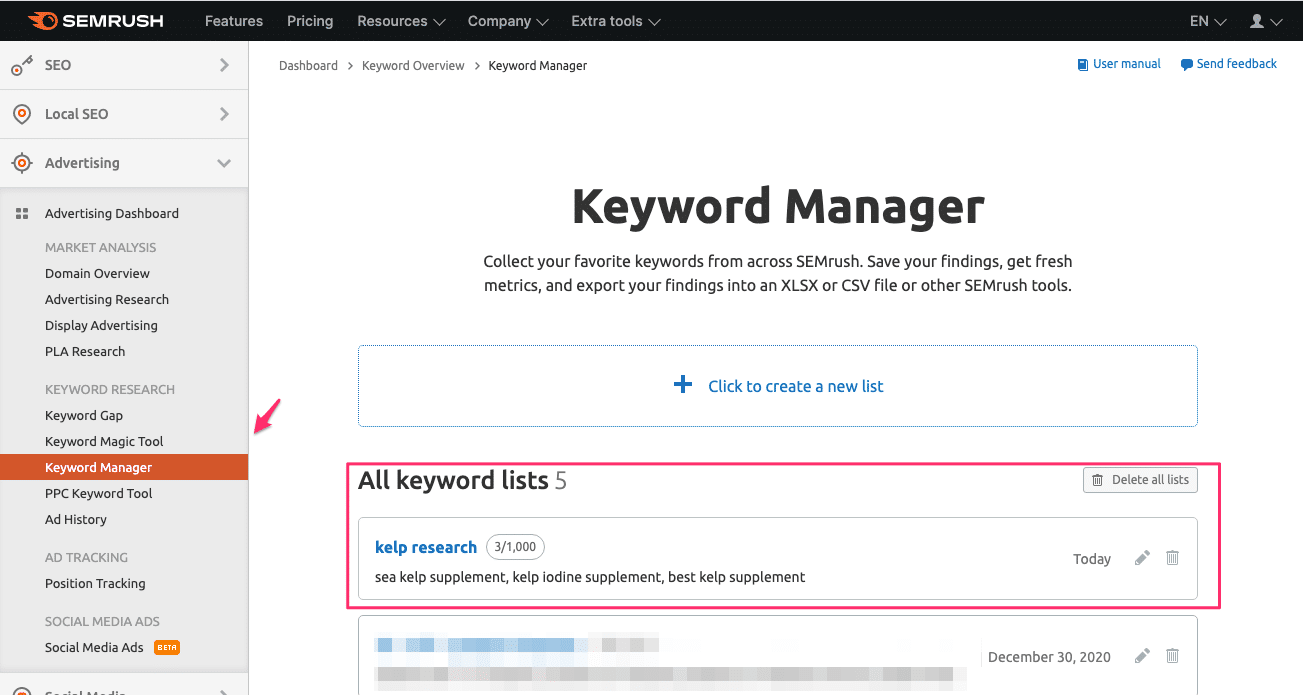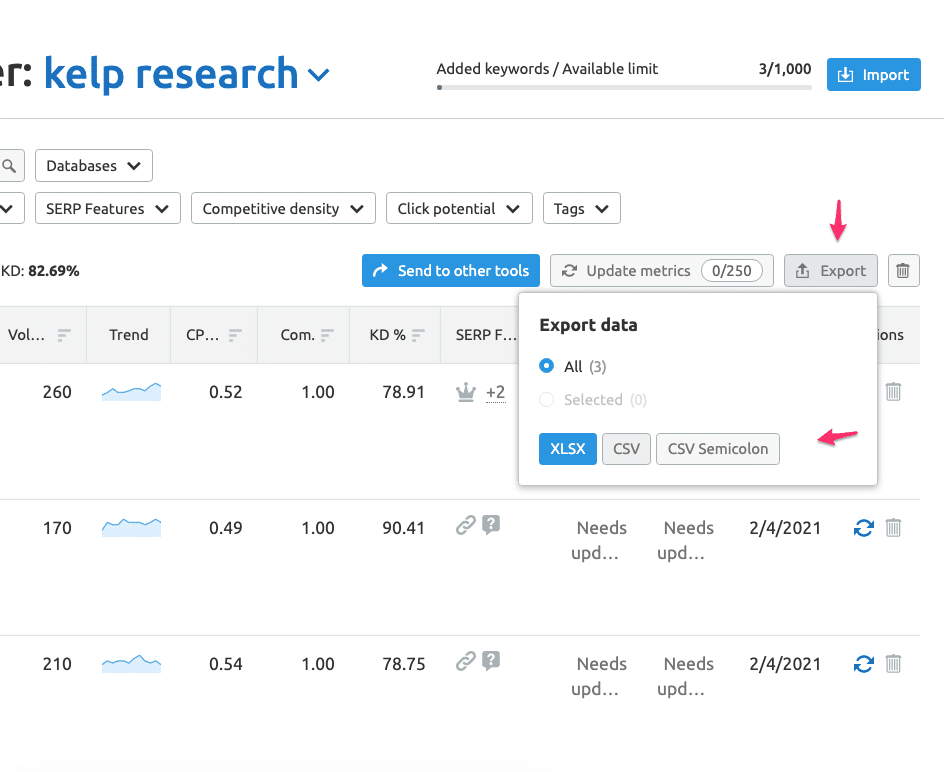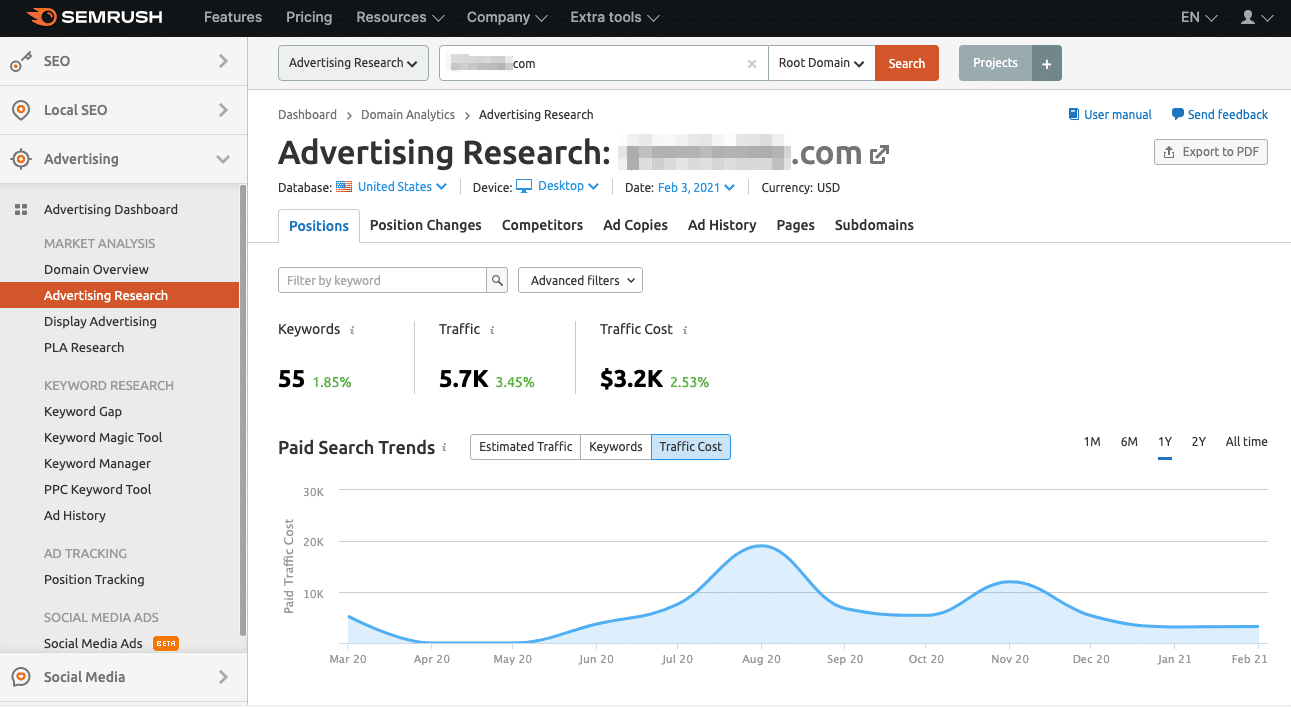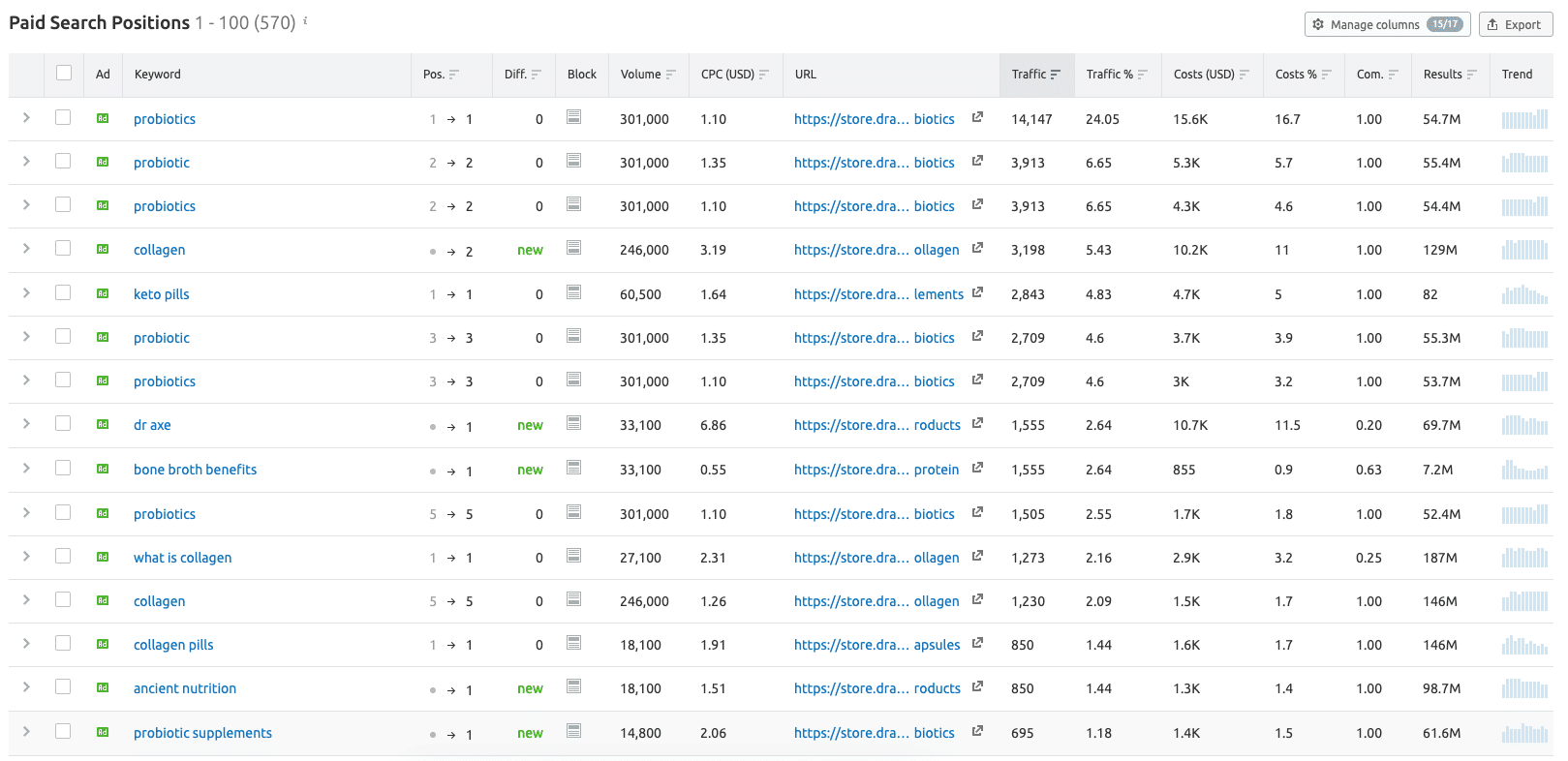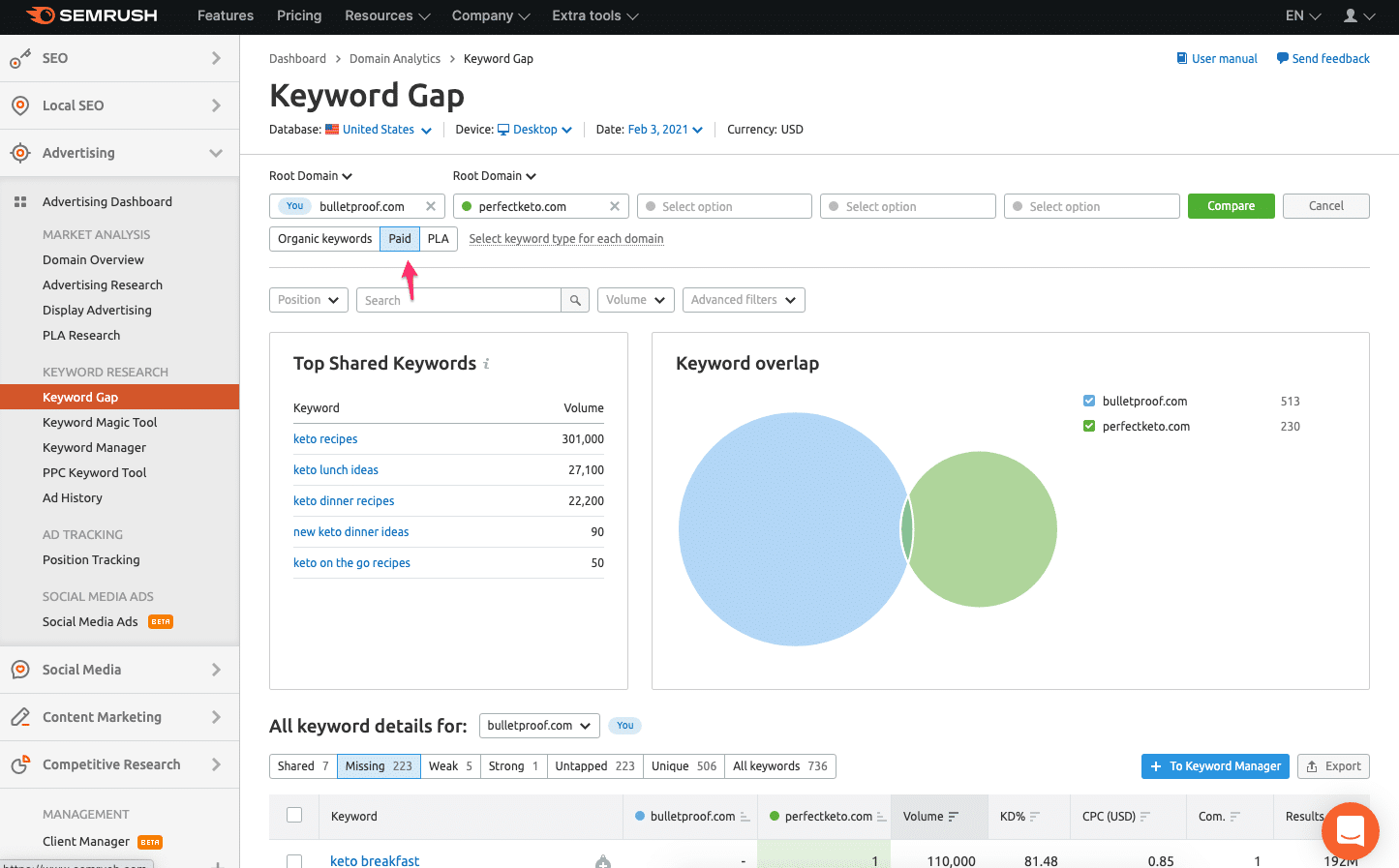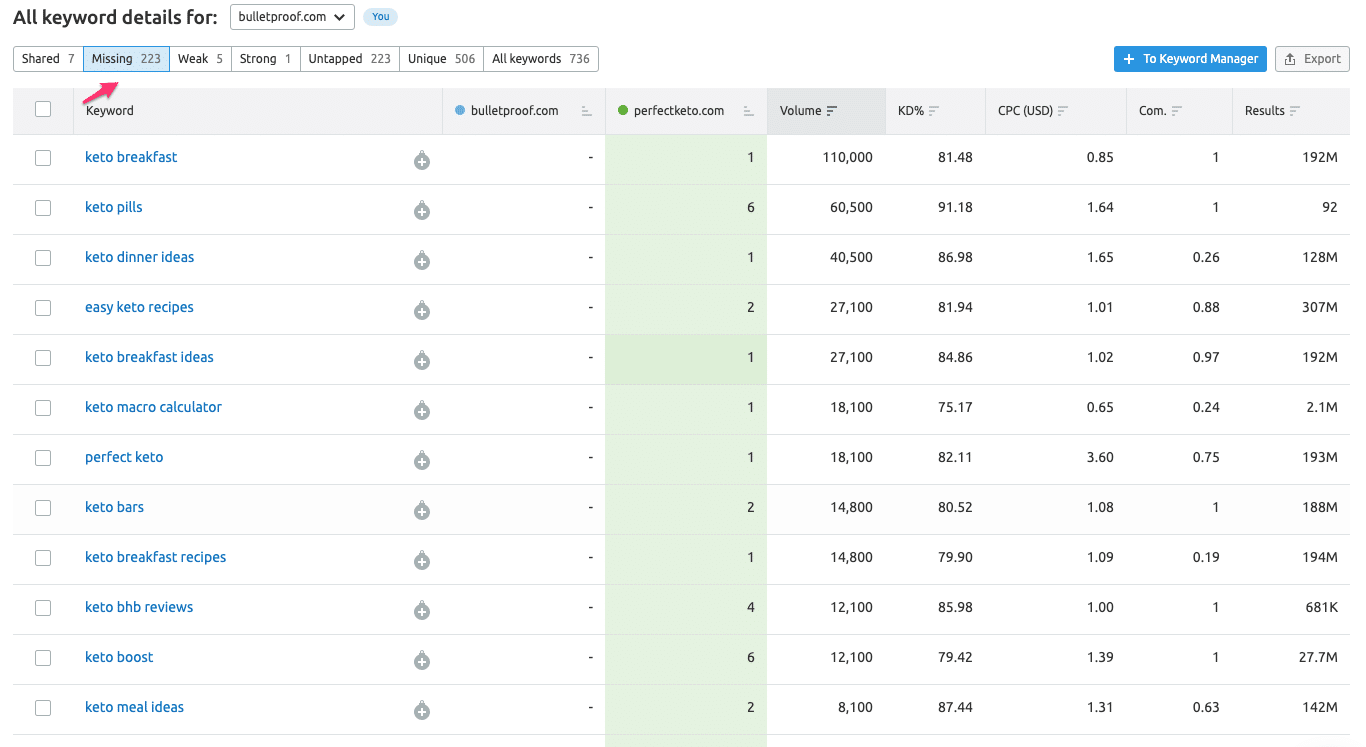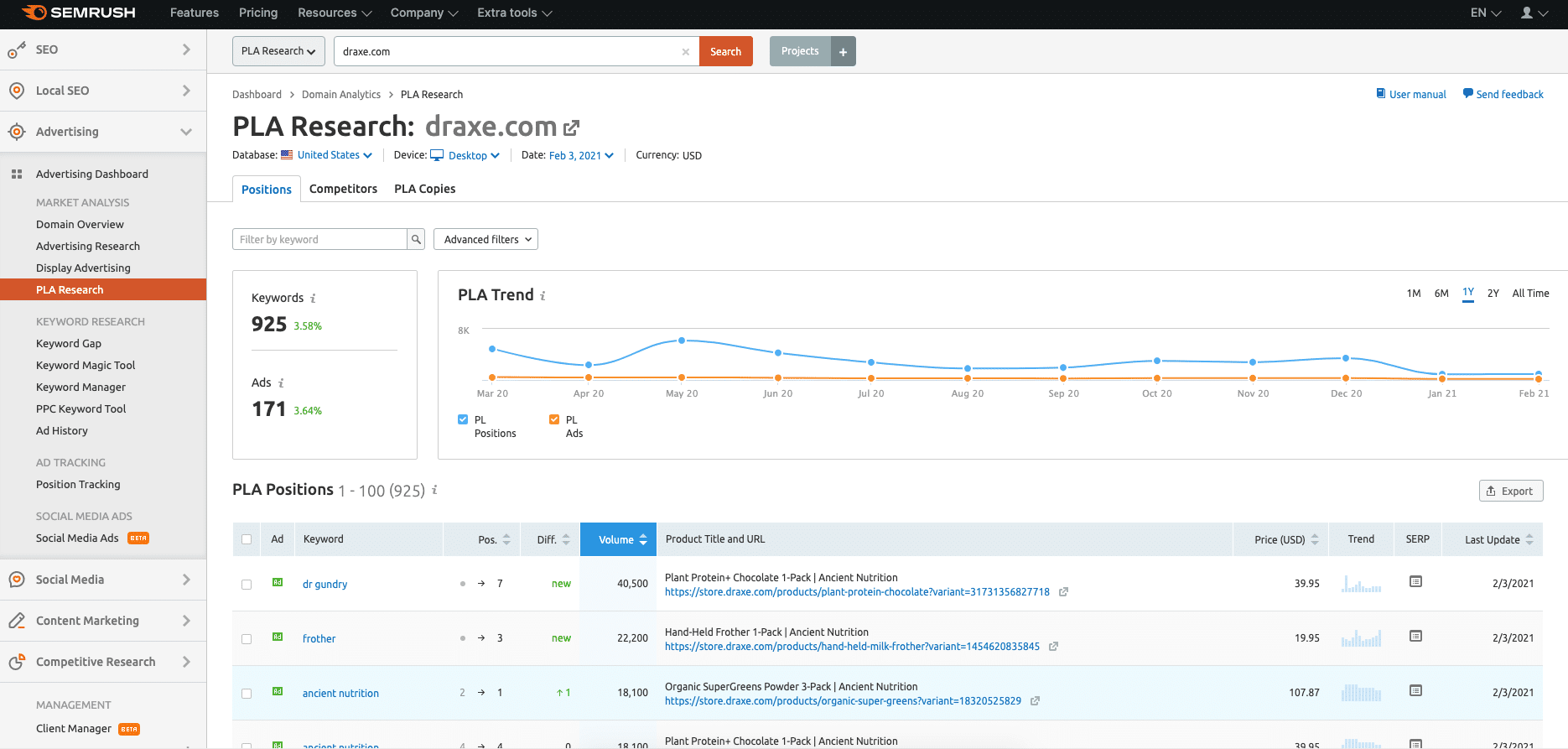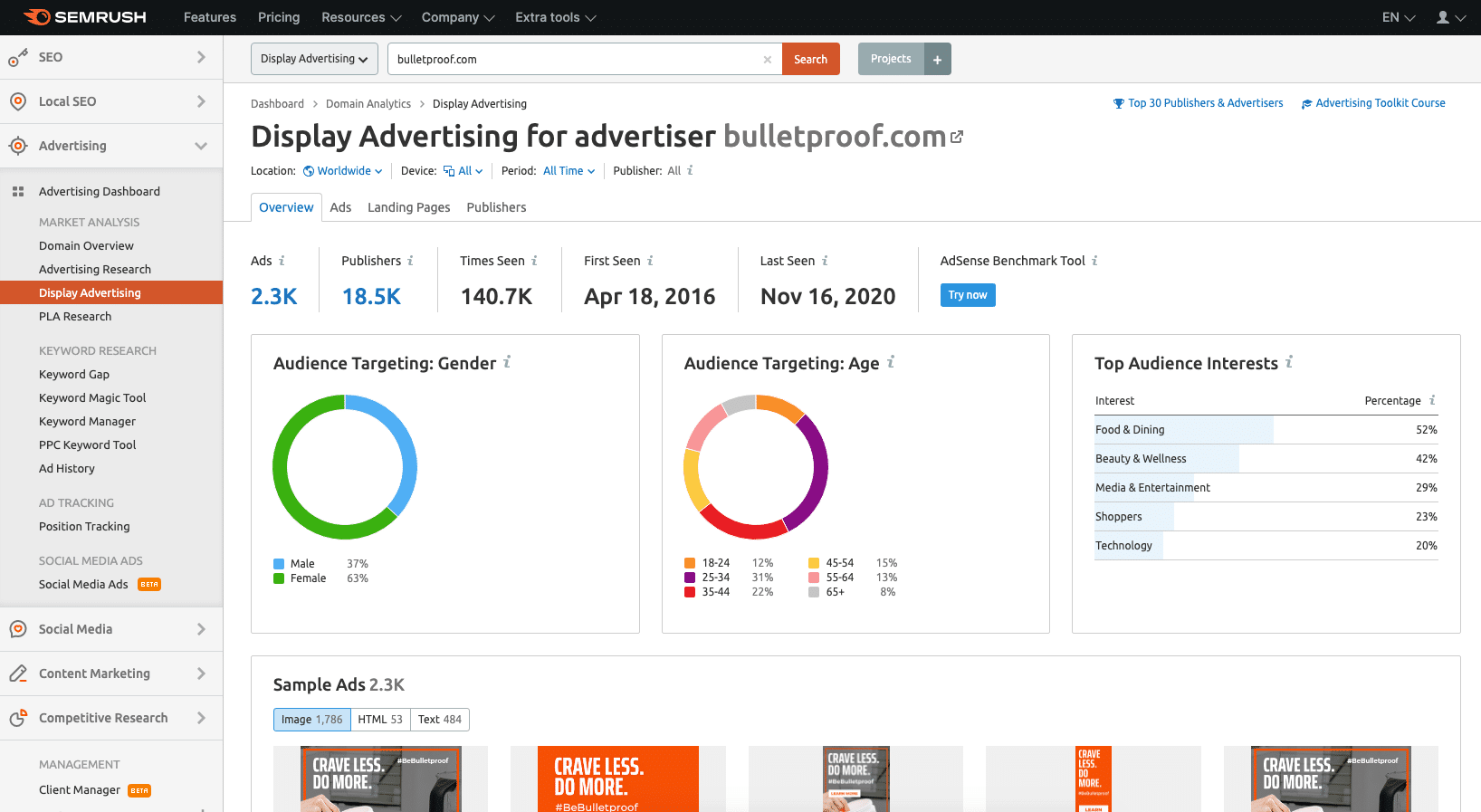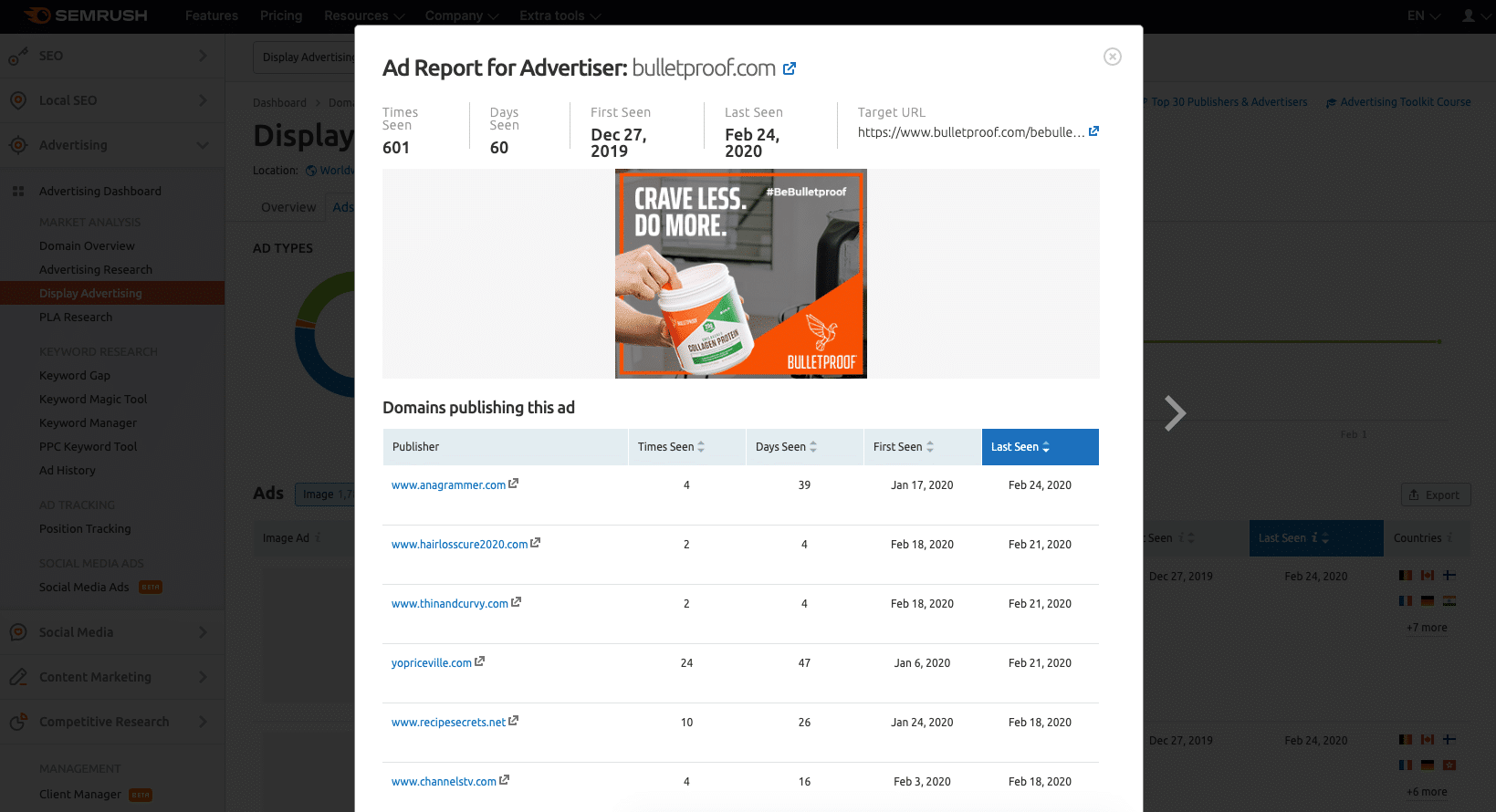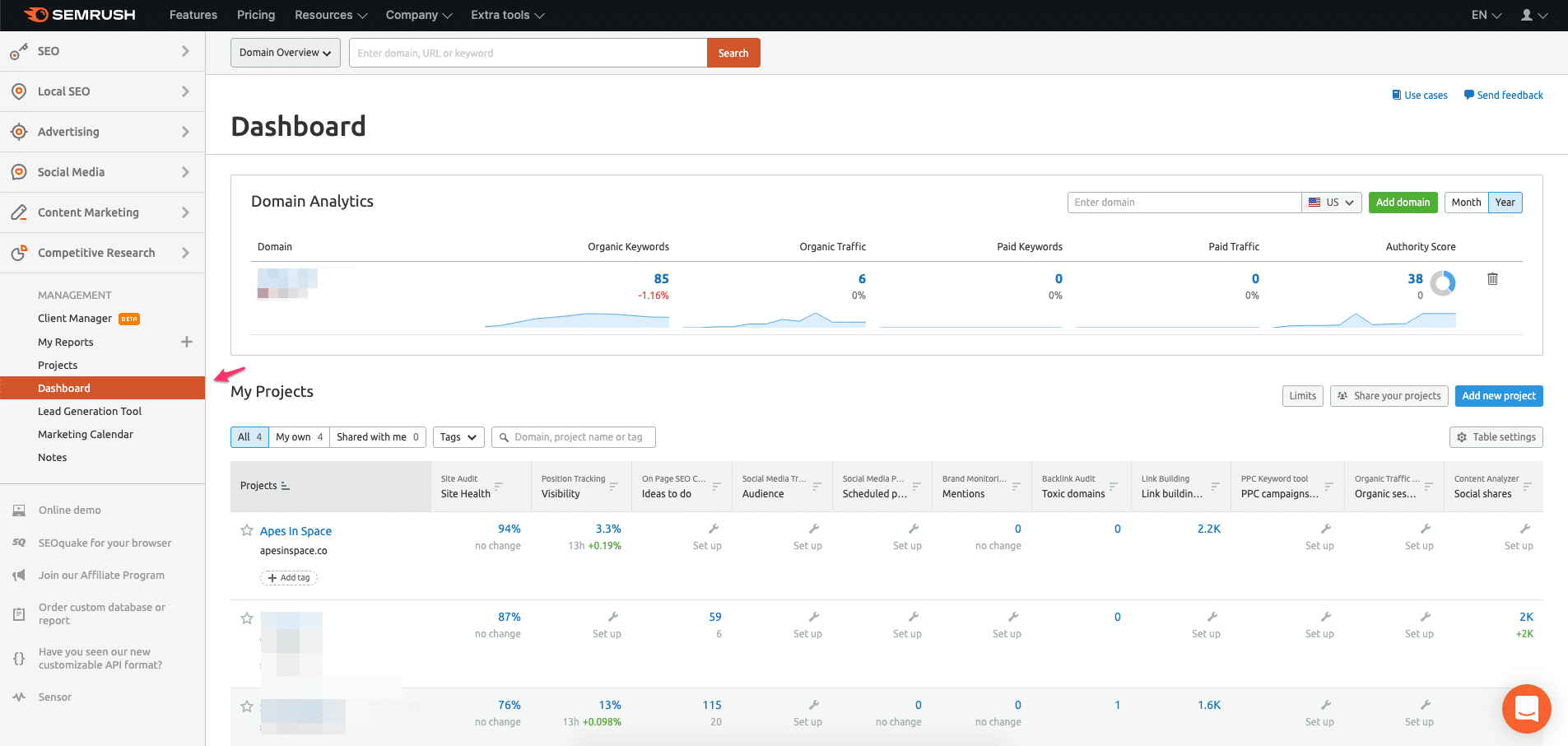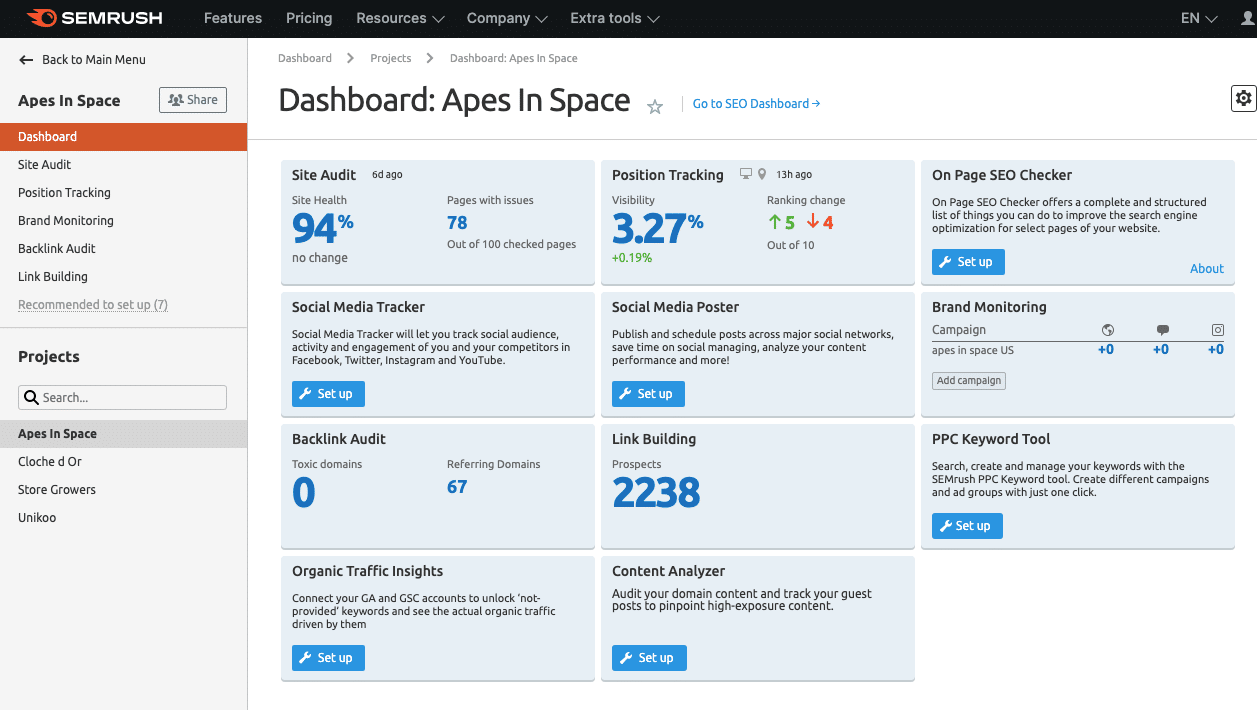When it comes to keywords research tools, Semrush is one of the top tools on the market.
I’ve been a customer of theirs for years because they have a pretty good combo of tools that cover both PPC and SEO. Most other tools focus on one or the other.
In this review, I’ll show exactly how I use Semrush and show you a few tricks.
Let’s dig in!
Disclaimer: some of the links in this article might be affiliate links. When you click them and end up purchasing, I get a small commission at no extra cost to you.
Table of Contents
What is Semrush?
Semrush is a collection of different tools to make SEO and PPC easier.
Its number one use case is to help you find interesting keywords. Second its competitive research for SEO or PPC purposes.
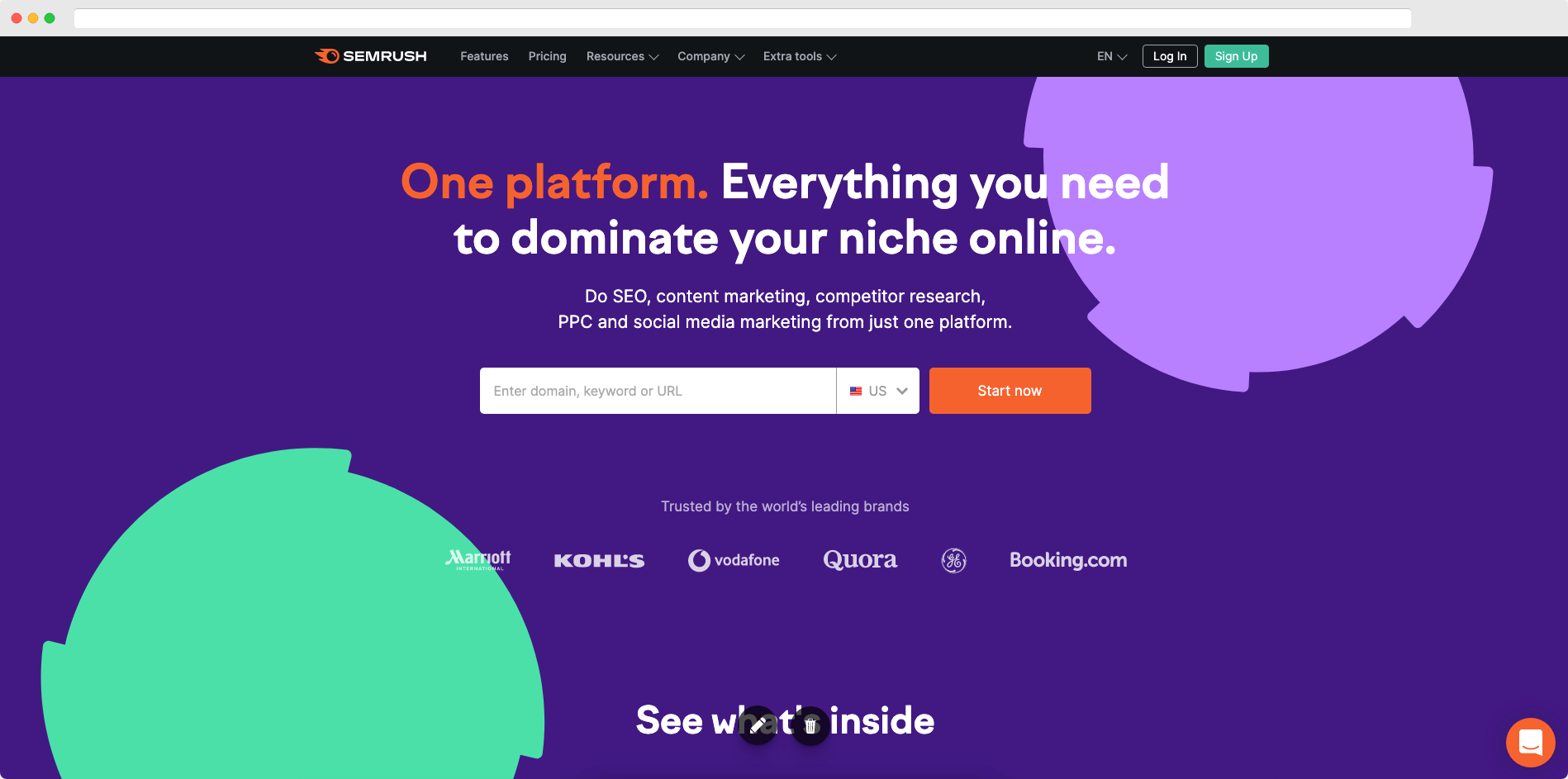
My annoyance has always been that I couldn’t find my way around the tool. I use it almost daily and always had to find which report I actually wanted to use.
It took a while, but together with a recent rebrand, Semrush has reorganized its menus. Now the tools have become a lot easier to use.
It now also remembers the URL you are searching a lot better. Before it was very frustrating that you had to re-enter the URL or keyword for almost every new report.
How I Use Semrush
Rather than give you a dry list of all features in the tool, I want to show you how I use Semrush in my daily workflow.
You can split my usage into 2 big groups:
- PPC: help client work or competitive research for my articles
- SEO: monitor and spot opportunities for my own websites
I know the tool can do a bunch of other things: social media monitoring, links monitoring, etc.
But honestly I’ve never gotten around to those parts (or had the need to do so).
So in what follows, I’ll focus on how I use Semrush as a PPC specialist.
Semrush Data Accuracy
Like most keyword tools, the data you see in Semrush is an approximation.
Whenever I run across a new site, I usually plug it into Semrush to see its traffic numbers.
Here is a quick comparison of the numbers from Semrush vs the actual visitor numbers (from Google Analytics).
| Semrush | Google Analytics | difference | |
| Site A | 9,498 | 24,826 | -161% |
| Site B | 293 | 440 | -50% |
| Site C | 91,512 | 32,018 | 65% |
| Site D | 15,813 | 19,994 | -26% |
| Site E | 825,826 | 455,369 | 44% |
| Site F | 19,123 | 12,586 | 34% |
You see that the numbers swing widely. For some sites it’s widely overreporting, while for others the opposite is true.
This probably has to do with where the sites are based, and how Semrush gathers its data. A deeper investigation might reveal why this is happening, but I’ll leave this for someone else 😉
So with that big of a difference, how useful are these reports really?
I use the numbers to give me direction and support data I get from elsewhere.
The keyword volumes in Semrush are more consistent, but I still don’t treat them as the truth, but more of an approximation.
With that set, let’s jump into the details!
Semrush for PPC
I spend most of my time running Google Ads campaigns. So I mainly use Semrush to be more effective:
- Keyword research for new campaigns or new clients
- Review PPC performance for prospects or coaching clients
- Get insights into PPC performance of competitors
- Research top brands and write articles about them 🙂
Keyword research
As I said before, the main reason I use Semrush is for keyword research purposes.
This is all about finding keywords for new clients, or working with existing clients to find new untapped parts.
For that I start with the Keyword Magic Tool.
You enter a seed keyword, and explore what comes up:.
Let’s explore this with an example “kelp supplements”:
What you find during your research usually falls into one of three buckets:
- Interesting keywords: you want to explore adding these into your campaigns
- Irrelevant keywords: keywords that would just cost you money (to add to your negative keywords!)
- Grey zone keywords: keywords that aren’t relevant, but aren’t great either.
Usually this exercise will surface a lot of aspects I had not considered.
Take this keyword: “arsenic in kelp supplements”.
To a customer, taking a supplement that contains poison is probably high on their list.
So we need to be making sure that we’re somehow messaging this information either in the ad, product title or website copy.
“The World’s First Arsenic Free Kelp Supplement”, or something a little better.
Next there are informational queries like “is kelp supplement good for you” or “when to take kelp supplement”.
Customers that search for these types of queries are usually early in the buying process. So it might not be worth spending money on them.
Important during keyword research is to stay organized. Luckily Semrush has a few tools that can help with that.
When you’re going through the Keyword Magic tool, you’ll see a little plus symbol next to each keyword:
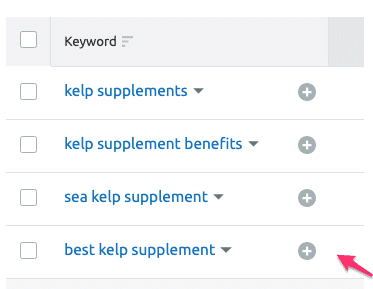
If you click that, you’ll be prompted to add it to a list:
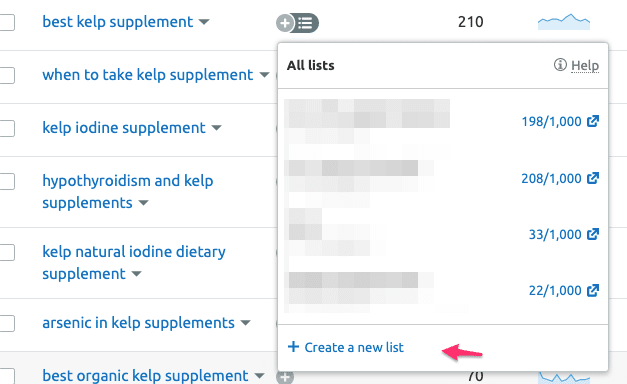
If you don’t have a list yet, you can create a new one.
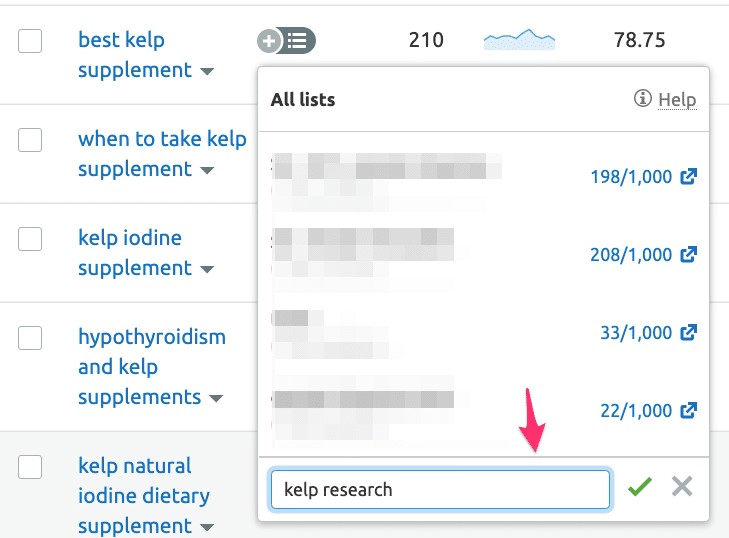
You can put in different seed keywords to find more good fits.
While going through those lists, you can quickly see green checks for keywords that are already on your list.
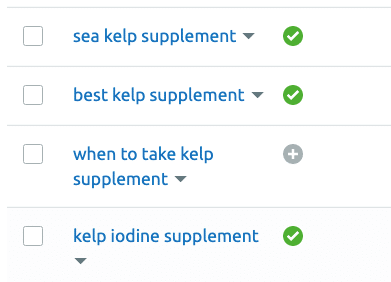
If you keep doing this, you’ll run into the same suggestions, which means you’re ready for the next steps.
Keyword Manager
When you’re done, you can goto the Keyword Manager, where you have a n overview of all your keywords.
Here is our kelp research list:
If we open that up, you get to see all of the keywords in your list, together with some key metrics:
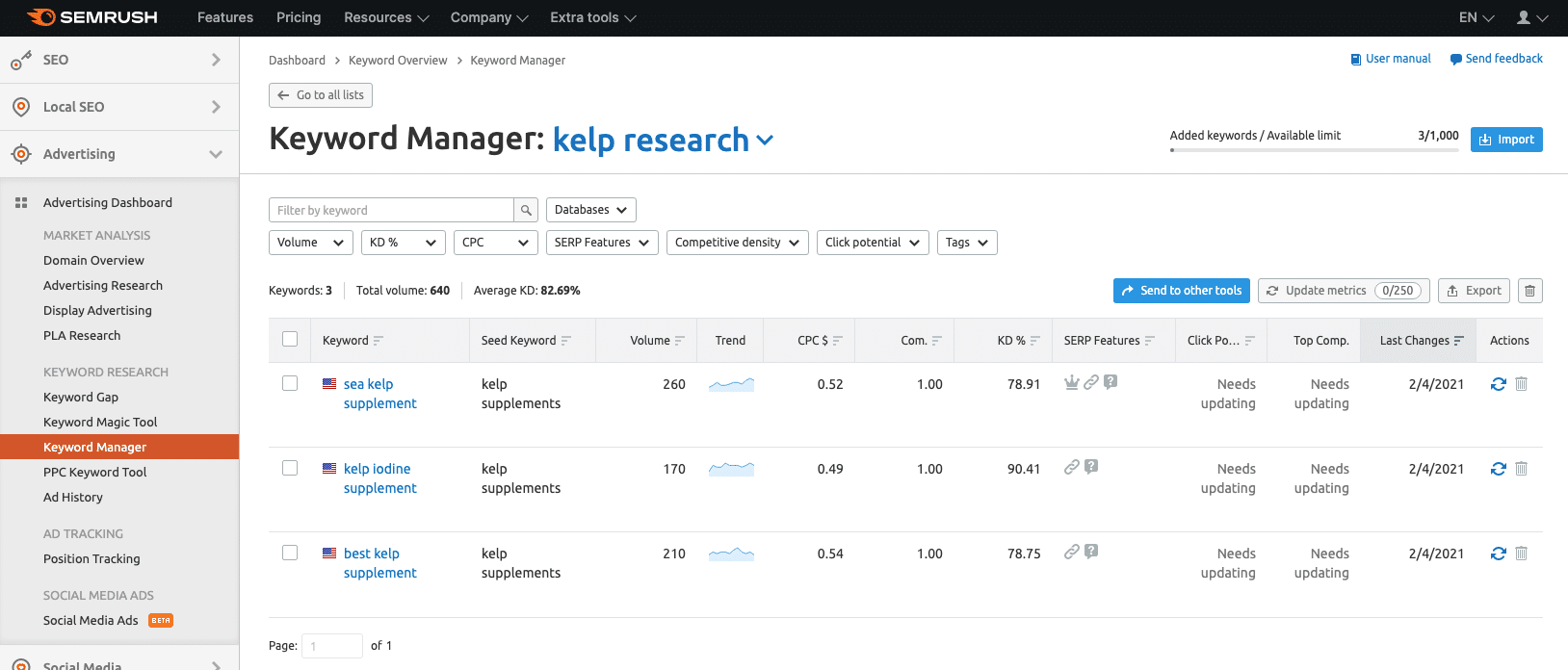
From here, there are a few directions you can go in.
Most often, this is where I export my data, and then take it into Google Sheets to further organize it:
If you want to get an idea about my full keyword research process, check out my guide.
Competitive Research
Part of using Semrush for PPC is for spying on competitors.
This can be competitors of mine, of my clients or just other sites I’m curious about.
Let me take you through some of the tools I use for that.
The starting point is the Domain Overview.
This answers the most basic question: is a website using Google Ads?
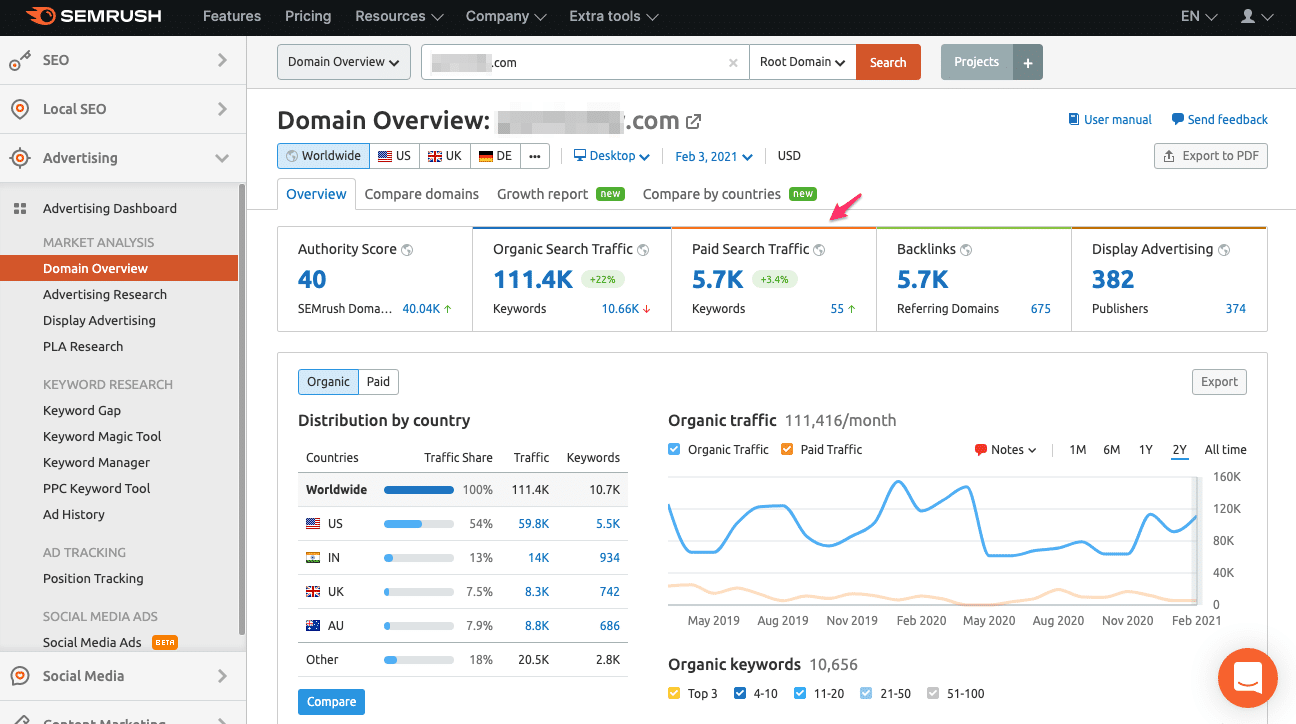
Besides that, you can use the chart to get an idea of seasonality, and aggressiveness with their campaigns.
When I’m talking with potential clients, they’re often surprised that I can say: “I see you tried some Shopping Ads last year, but I see you’ve stopped now.”
That immediately gives you something to talk about 🙂
Competitor deepdive
The next report I look at for competitive research is the Advertising Research report.
This dives a little deeper into the Paid search side of things:
- Keywords
- Traffic
- Traffic cost
Let’s quickly review the data accuracy for this US-based advertiser:
| Semrush | Google Ads | difference | |
| Keywords | 55 | 127 | -130% |
| Traffic | 5700 | 24,526 | -330% |
| Traffic cost | $3,159 | $19,763 | -525% |
These numbers again aren’t that satisfying.
Looking from the outside, you would seriously underestimate the amount of traffic and sales that this business generates from Google Ads.
If you’re looking into getting into a new market, it’s worth repeating the same research from 3-5 other advertisers and see if all those numbers.
Paid Search positions
Let’s take a look at the paid keywords for draxe.com:
Here is how I use this report:

This report reveals which keywords and advertiser uses, and how important that particular keyword is.
The last column in the screenshot above, Traffic %, will tell you what percentages of all paid search traffic is coming from that keyword.
So that means that Dr Axe gets more than 37% of its traffic for probiotic related keywords.
Position will tell you about how aggressively this advertiser is bidding.
If you see a position of 1-2 for keywords with a search volume of 301,000, you know you’re in the big leagues 🙂 In this case that would work out to $14,000 per month, just for this keyword!
I also like to analyze the URLs in this report. You’ll see where they are sending their traffic and whether they’re doing any split tests.
That’s how discovered how survival brand Judy was testing a special landing page:

Branded / non brand
If you want to be really through, it’s a good idea to go through the complete keyword list.
You can use some filters on top of the chart to help you dig through.
Here is for example a filter that will take out all of the branded traffic, allowing me to look at their generic paid search performance.
Keyword Gap
If I’m working with an advertiser that’s already running campaigns, it can be interesting to run the Keyword Gap report.
This will compare up to 5 competitors, and spot keywords that one is targeting but the others aren’t.
Here is what the Keyword Gap report looks like:
Note that you can switch between Organic, Paid & PLA.
In the screenshot above, I’m comparing perfectketo.com with bulletproof.com, both selling health supplements.
The overlap is pretty minimal, but the report below is very interesting:
The most important tab is Missing. These are all keywords that perfecketo.com is actively bidding on, and that bulletproof isn’t:
It could very well be that most of these keywords don’t make sense for the other site. But just looking through the list will give you a lot of ideas.
Another interesting tab is Weak:
These are keywords that bulletproof is bidding on, but it’s getting outbid by its competitor. So if these are important to the business, they need to be looked at closer inside Google Ads.
But of course, there is more to Google Ads than just Search Ads!
PLA Research
(PLA is short for Product Listing Ads, the old name for Shopping Ads)
Semrush is one of the only tools of its kind that supports research relating to Google Shopping Ads.
Their PLA report analyzes two things:
- Keywords
- Ads
But the reports you can get on their Pro plan (their most basic one) are pretty limited:
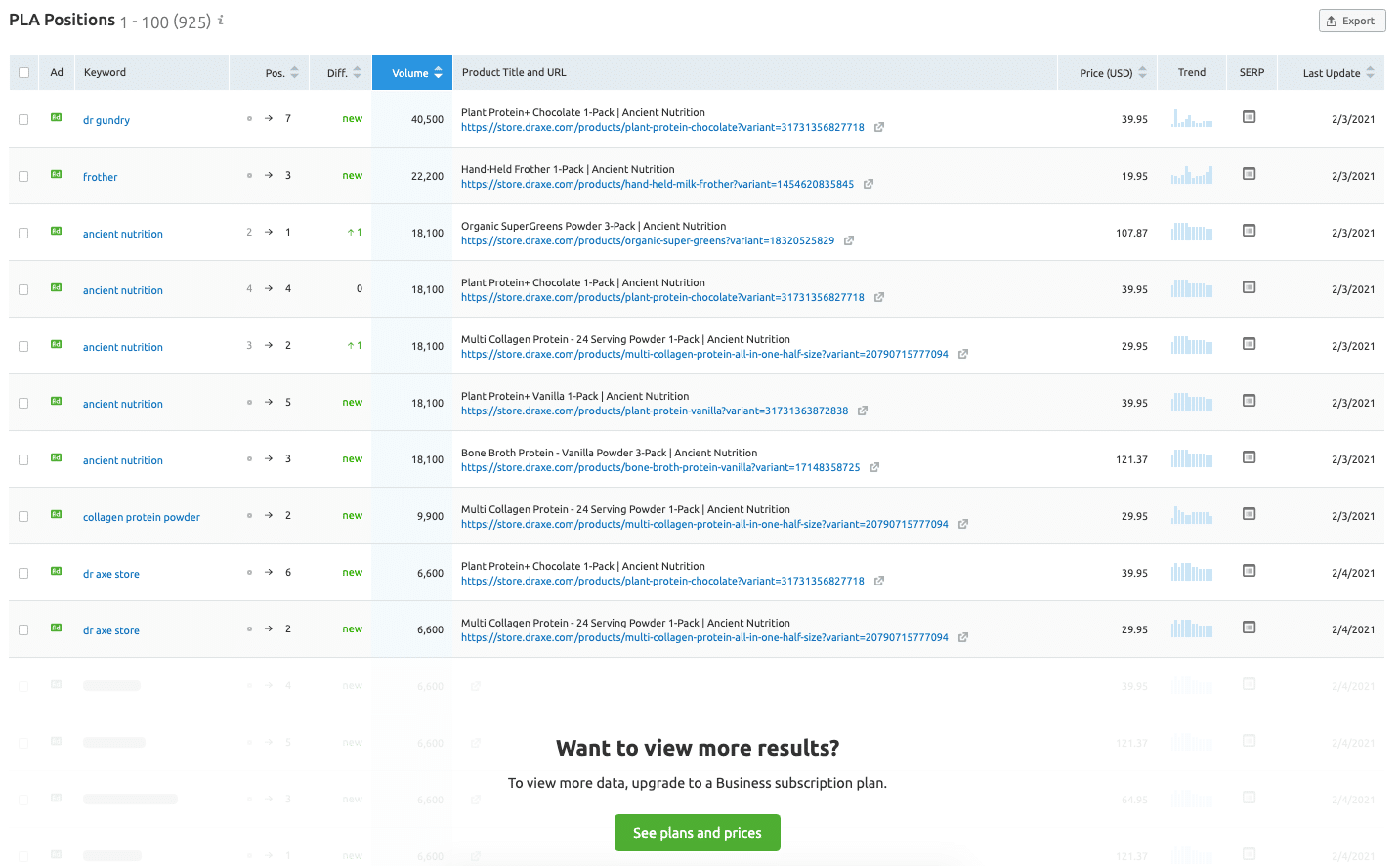
You only get the first 10 lines of the report. That Full PLA data is only available on their Guru plan, which, at $449.95/mo, is a little too expensive for my taste 🙂
So what can we learn from this limited set of data?
First of all we learn if an advertiser is using Google Shopping or not. You can also look at the graph to spot any potential trends or hiccups they might have had.
Second, the keyword report shows you the 10 keywords with the highest search volume. This doesn’t mean that they bring the most traffic for an advertiser.
Although this is a VERY limited sample, you can sometimes get some ideas on what to improve.
Like when I suggested beauty brand Glossier adapts its Google Shopping strategy based on that report 🙂
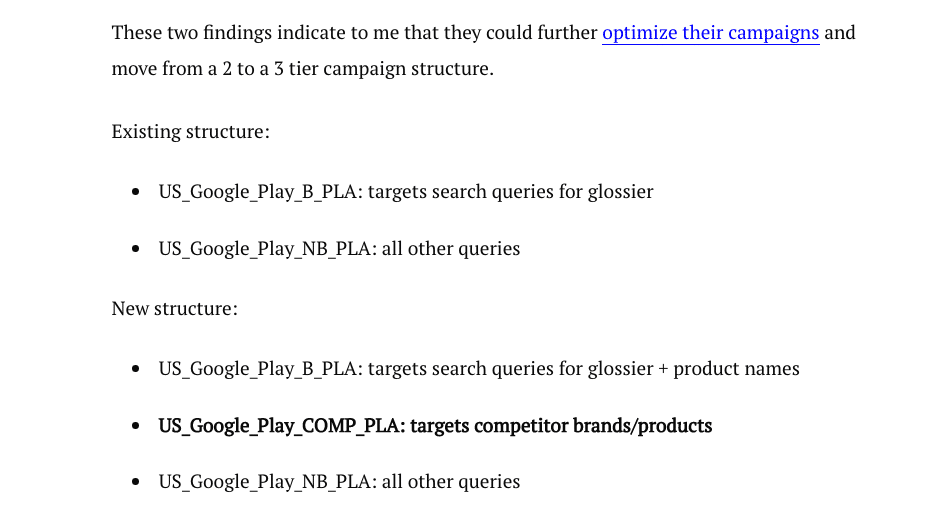
Lastly, we can have a look at their URLs to see where they are sending the traffic. Similar to the Search Ads, that can reveal some interesting approaches that brands are taking.
Display Advertising
The last section I look at when researching new domains is the one for Display Advertising.
Not that these are all the Display ads this advertiser runs, so it’s not just limited to Google Display network but also other networks.
Here is the Display report for Bulletproof.com:
The most obvious part of this section is the actual creative. What kind of banners are they running, what products are featured.
Almost all the ads I can find for Bulletproof are for its collagen product:
Note that Semrush will also tell you how long certain ads have been running.
The one in the example above only ran for about 2 months, which could be an indication that they’re using Display for campaigns or as a way to introduce new products.
For advertisers that are running a lot of Display Ads, I think the Landing pages report is a pretty interesting one.
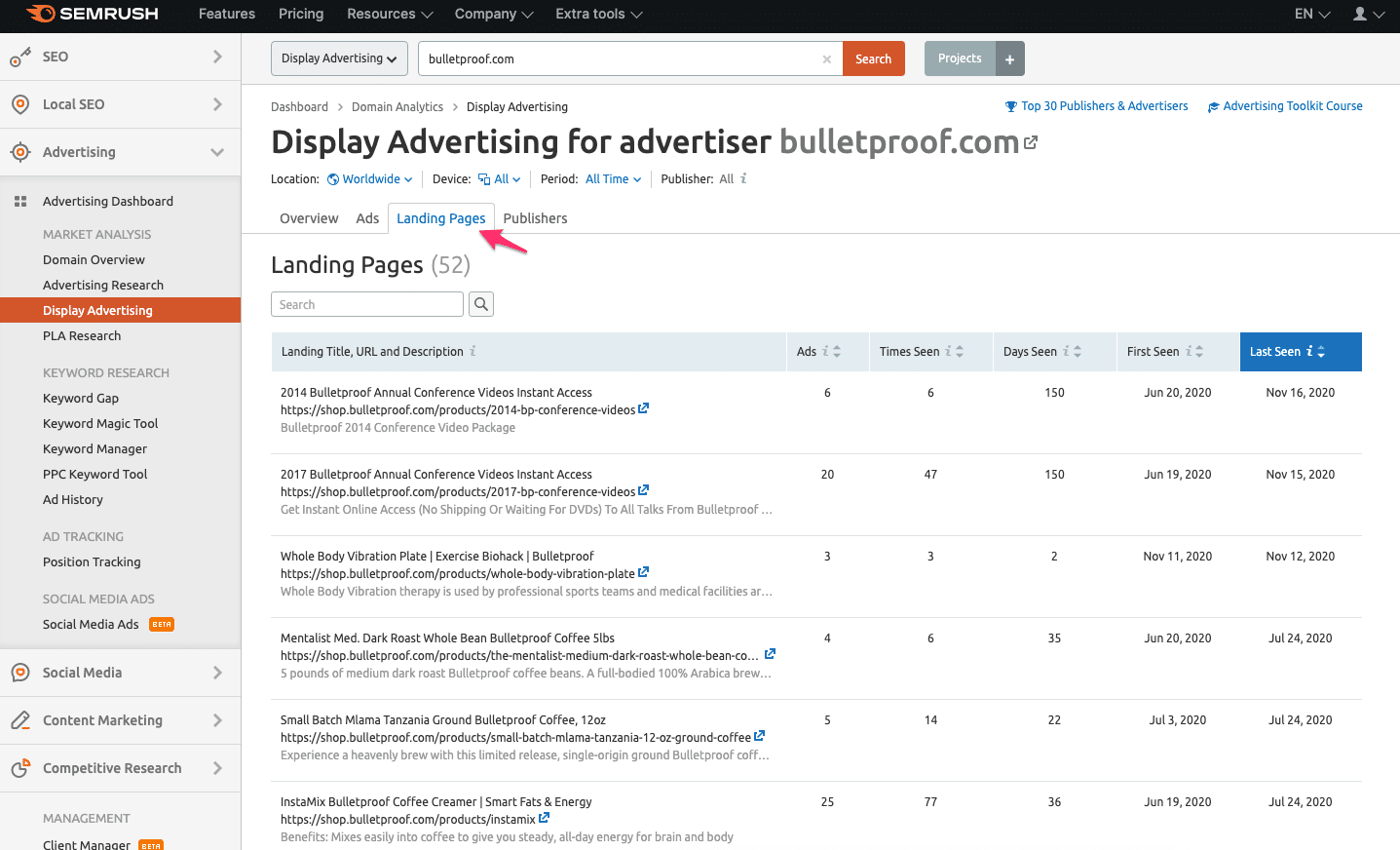
This will give you an overview of all landing pages, which can be sorted by number of ads, time seen or days seen.
This allows you to explore all of the (expired) offers they’ve been pushing.
Semrush for SEO
Since I don’t offer any kind of SEO services, I only use Semrush to do keyword research for my content marketing, and to track my keyword rankings.
So if you’re an SEO professional, there might be a ton of other features that are useful!
One thing I want to mention here is the Projects section Semrush. This is to add sites that you like to keep track of over time:
Here is what that looks like for my space poster store:
You can see a lot of tools:
- Site audit
- Position tracking
- On page SEO checker
- Brand monitoring
- Link building
- Etc.
You can see from the screenshot that I haven’t even set up all of them.
But let me go into more detail on the ones that I use most often:
Position tracking
The position tracking is one of the parts I check most often.
The overview gives you a visibility score (3.27%), which I don’t find that useful.
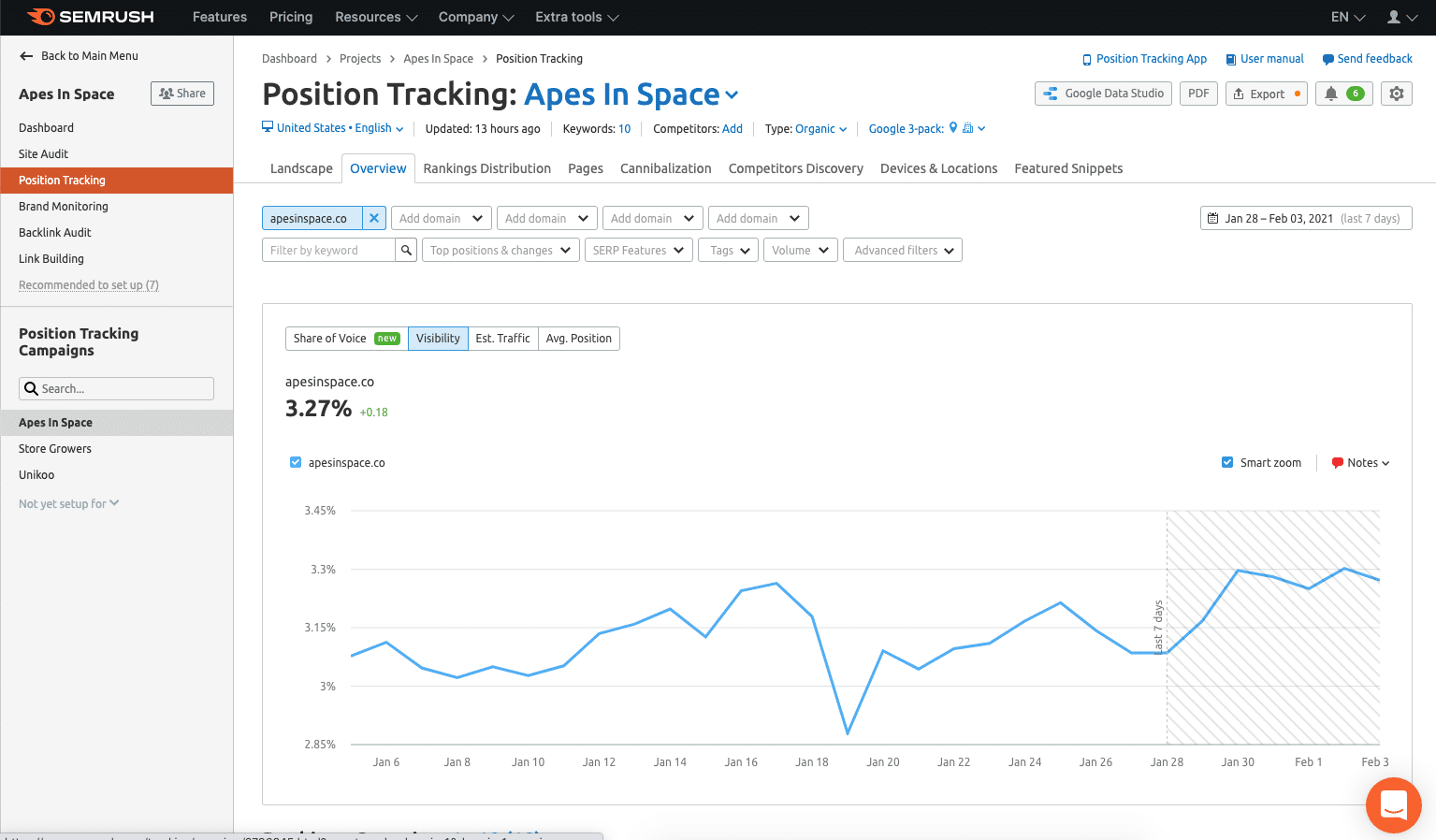
Because the moment you add or remove keywords, your score will change, rendering all the past data useless.
So instead of the overview, I usually look at the Pages report:
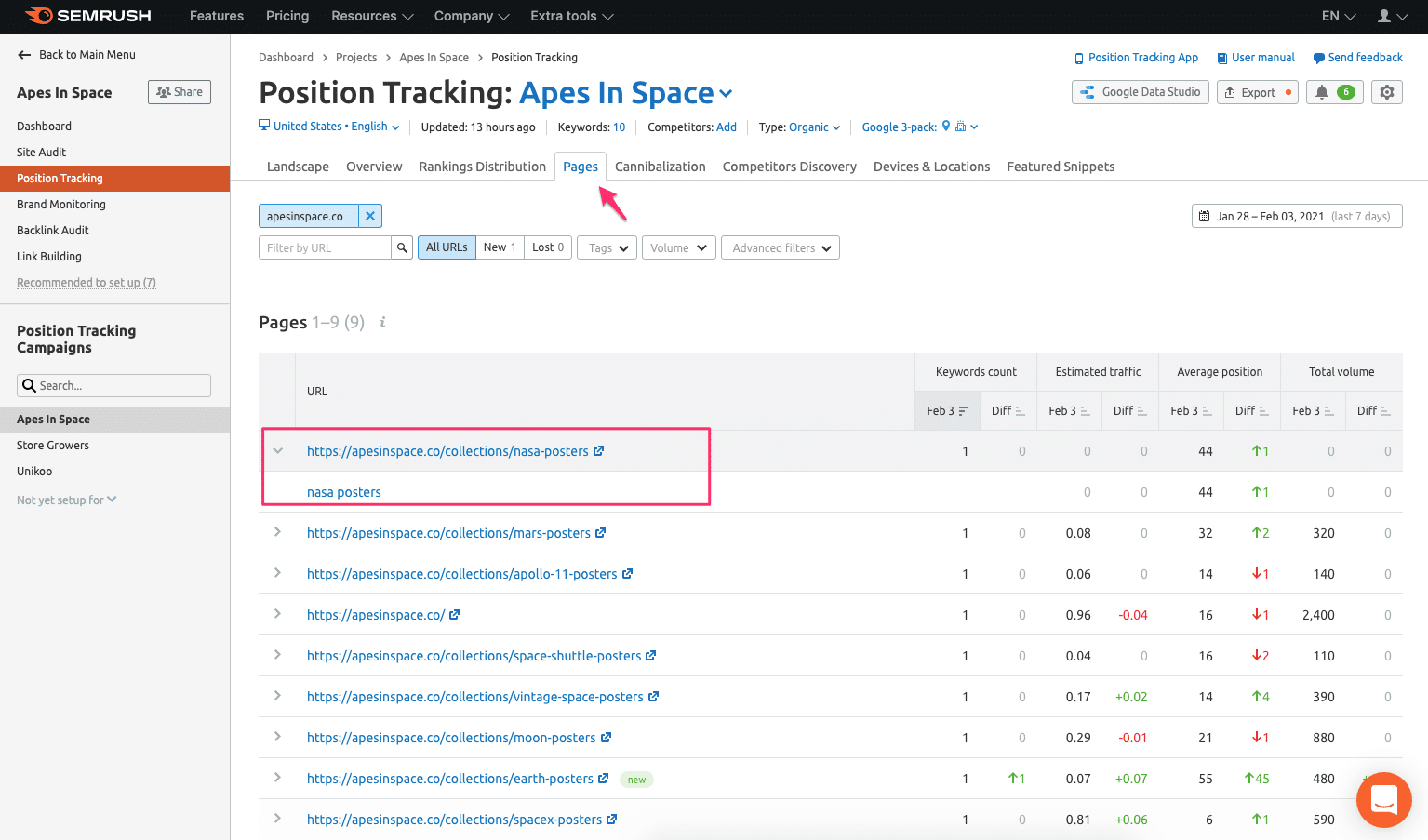
That tells me which URLs are ranking, and which keywords they are ranking for, at which position.
Site Audit
The other tools I’ve set up on a recurring basis is the Site Audit report.
It basically crawls my site and give me a list of all errors:
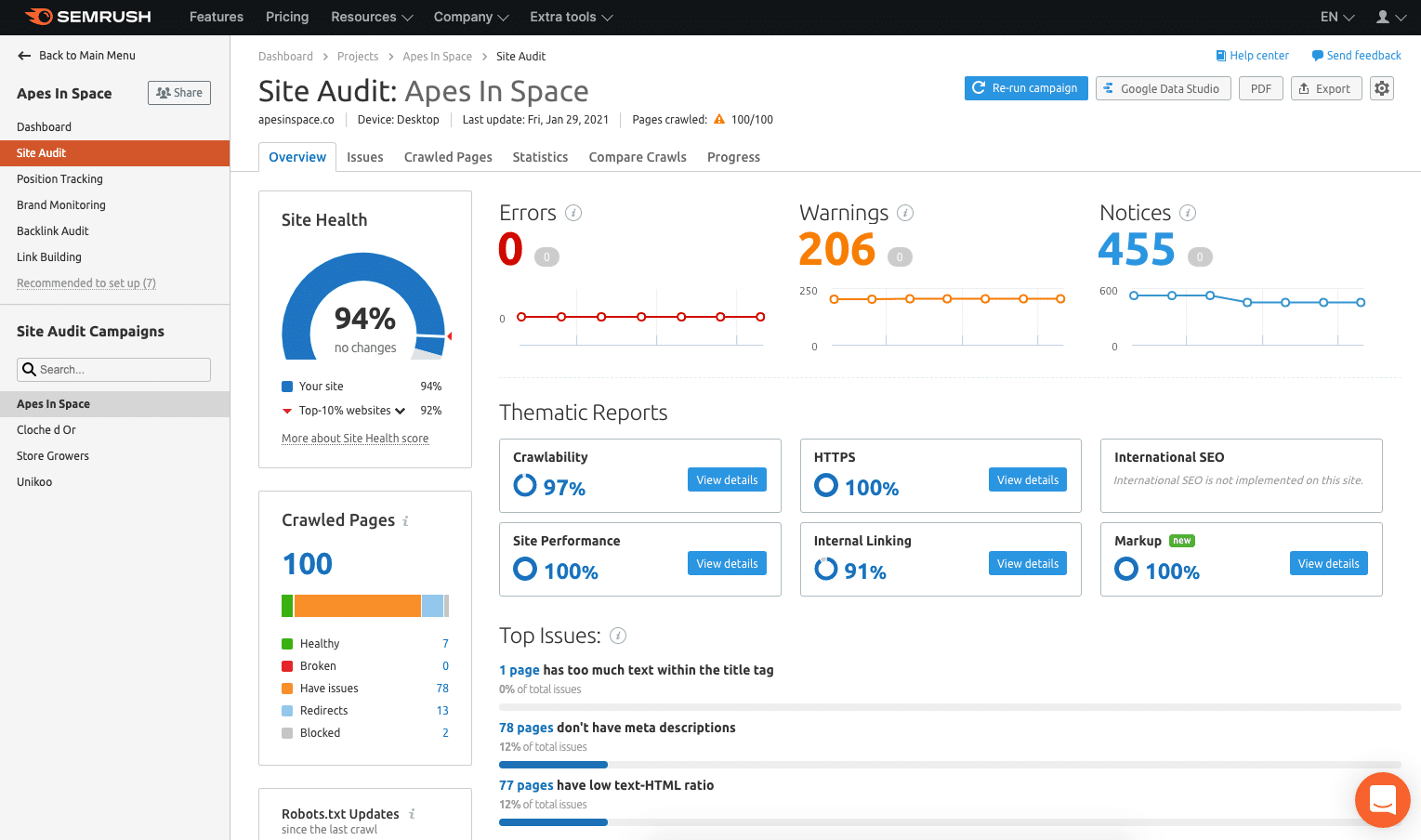
I don’t pay a lot of attention to the small things. But when I’m doing some work on the site, I might have a look at the problems that are listed here and tackle them.
Usually these are broken links, redirects or duplicate content.
But I hope that if something were to go seriously wrong with my site, I would see it here 🙂
SEO Writing Assistant
As I mentioned, Semrush also has a bunch of tools that will help you with content marketing, it’s called their Content Marketing Toolkit.
I haven’t explored it in a lot of detail yet, so far I’ve only used the SEO Writing Assistant.
It’s a Google Docs add-on that gives you SEO improvement advice on your content in real time.
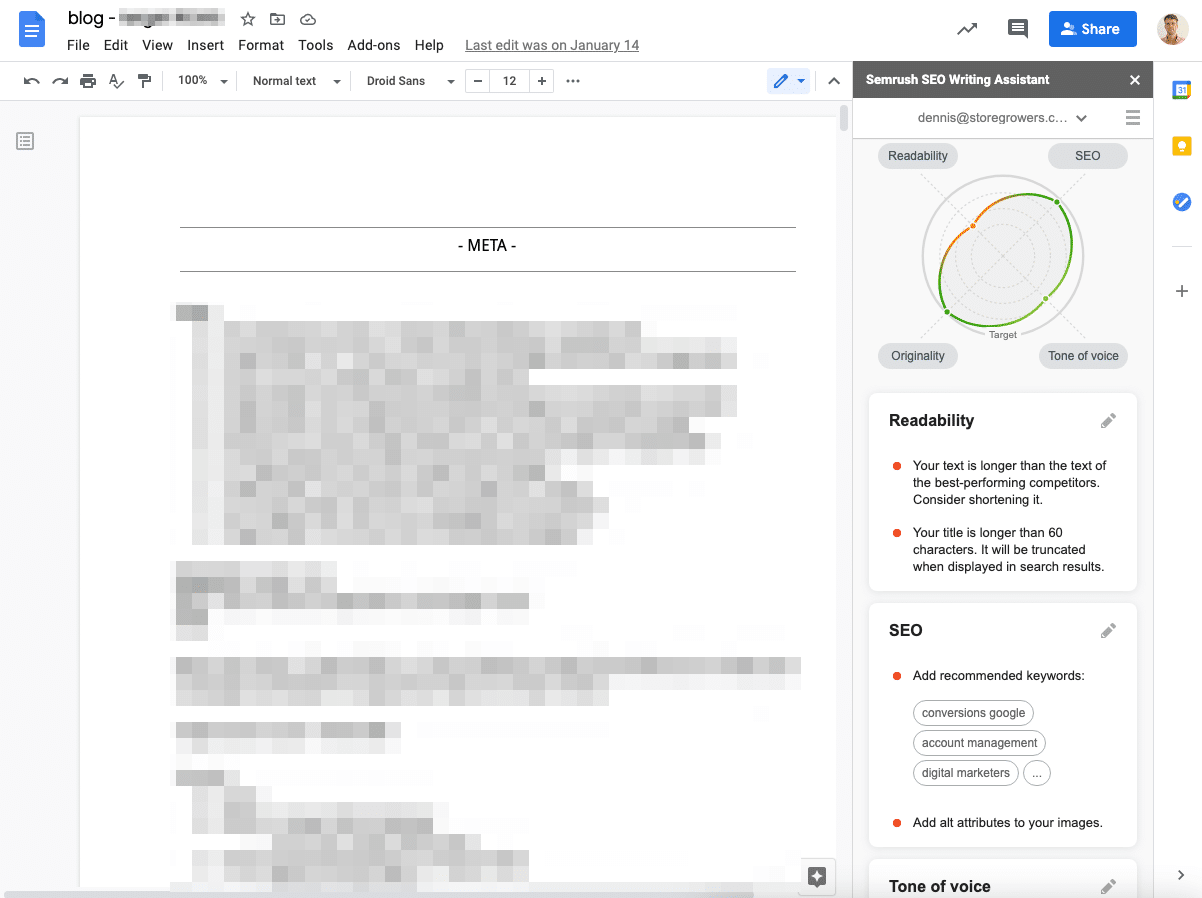
Like which keywords to include:
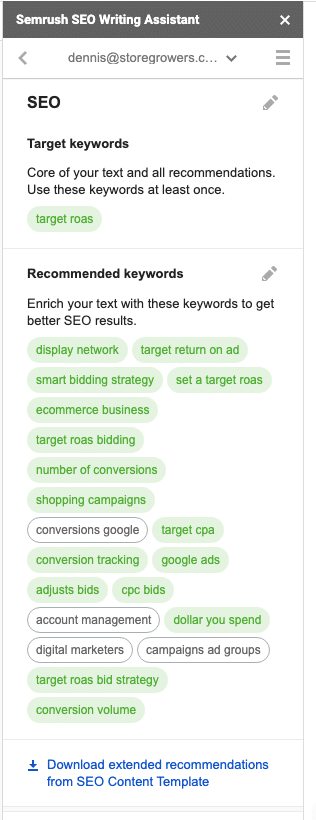
I’ve tried many of these SEO improvement tools and find most of them pretty basic.
So I’ll usually do my own keyword research, write the first draft and only then switch on the add-on to help me with and even wider variety of keywords.
Another nice feature is that it compares your content to that of other domains that are ranking for the keywords you’re trying to get:
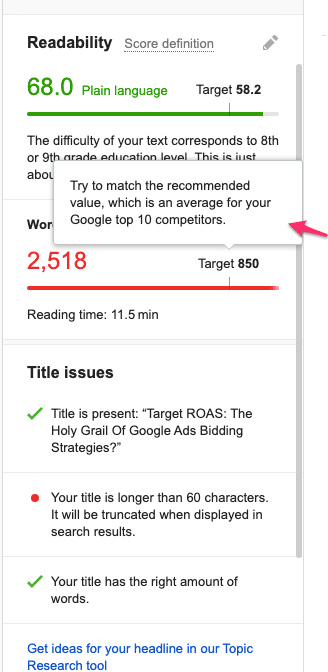
Like in this example, it said my content was way too long.
I used to be a fan of just cranking out as many words as I could. But paying attention to the length of the content that’s already ranking can help you adapt to what users might be expecting.
Semrush Pricing
Now that I gave you a breakdown of how I use Semrush, let’s discuss cost.
Semrush has a free 7-day trial (which requires a credit card).
After that, plans start at $119.95/mo.
That’s the Pro plan, which I’ve been using for a couple of years.
Here is what their pricing looks like:
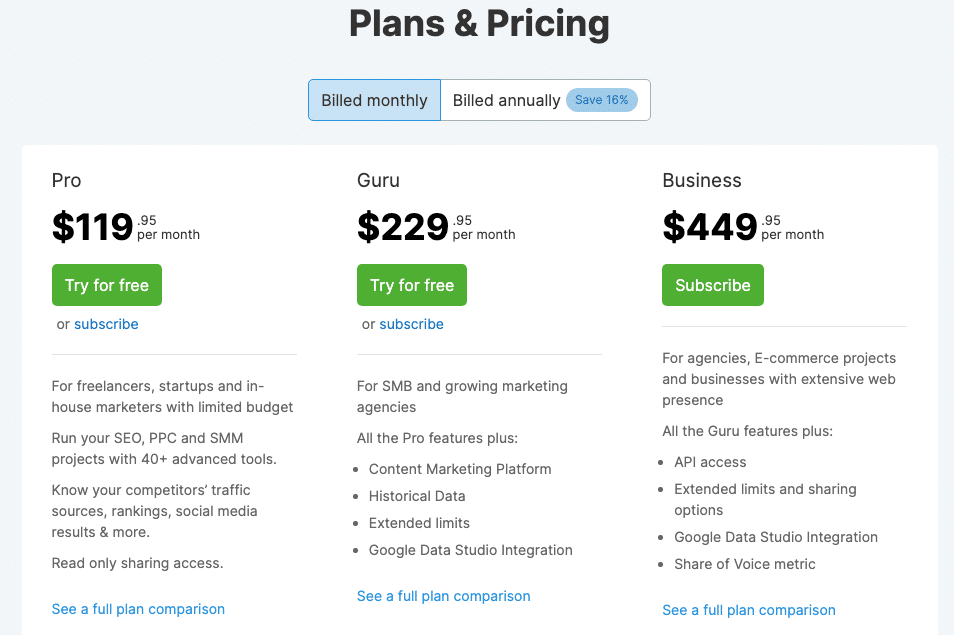
For most people, the basic plan will be sufficient.
If you’re not working in PPC or SEO, you might not be able to justify paying for this tool year round. And that’s totally cool!
I’ve seen a lot of smaller businesses sign up for tools at the start of a new project, use it for a month or two, and then cancel.
Sharing an account with multiple people is doable, but you will be logged out if someone else logs in
Semrush Store Growers Score
We conclude like all our tool reviews with a score.
Here is how that breaks down:
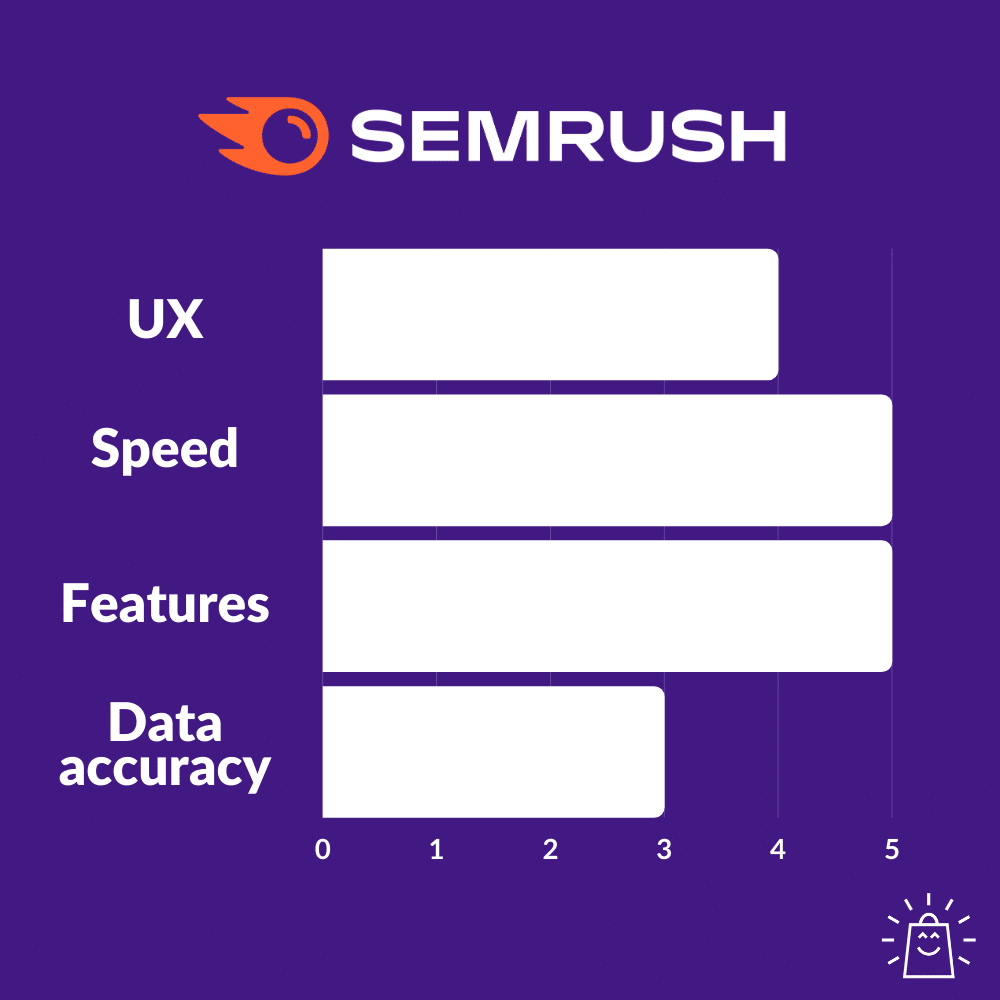
UX
4 / 5
The previous interface was pretty flawed, but with the recent changes, things have really improved.
I give it a 4 and not a 5 because while the general navigation is solid, inside the different reports it can be hard to understand what will be in a certain tab, requiring a lot of extra clicks to track down the right report.
Speed
5 / 5
No issues there.
Features
5/5
As I mentioned a couple of times in this review, I’ve been using Semrush for a couple of years and I still don’t use all the tools.
I follow them on Twitter and they sometimes post about things that i’ve never heard of, but that are in my account.
Data accuracy
3 / 5
I’ve shown a couple of comparisons of actual data vs tool data.
It’s not ideal, but it’s a fate that’s shared by all other tools. Even Google, which has all of the exact info, is no longer releasing accurate search query and volume data.
That said, there is a lot of room to improve to add more sources of data and make the difference between tool vs reality a little smaller.
Semrush Alternatives
This really depends on what you’re going to use the tool for.
If you’re focused on SEO, Ahrefs is a pretty awesome tool as well:
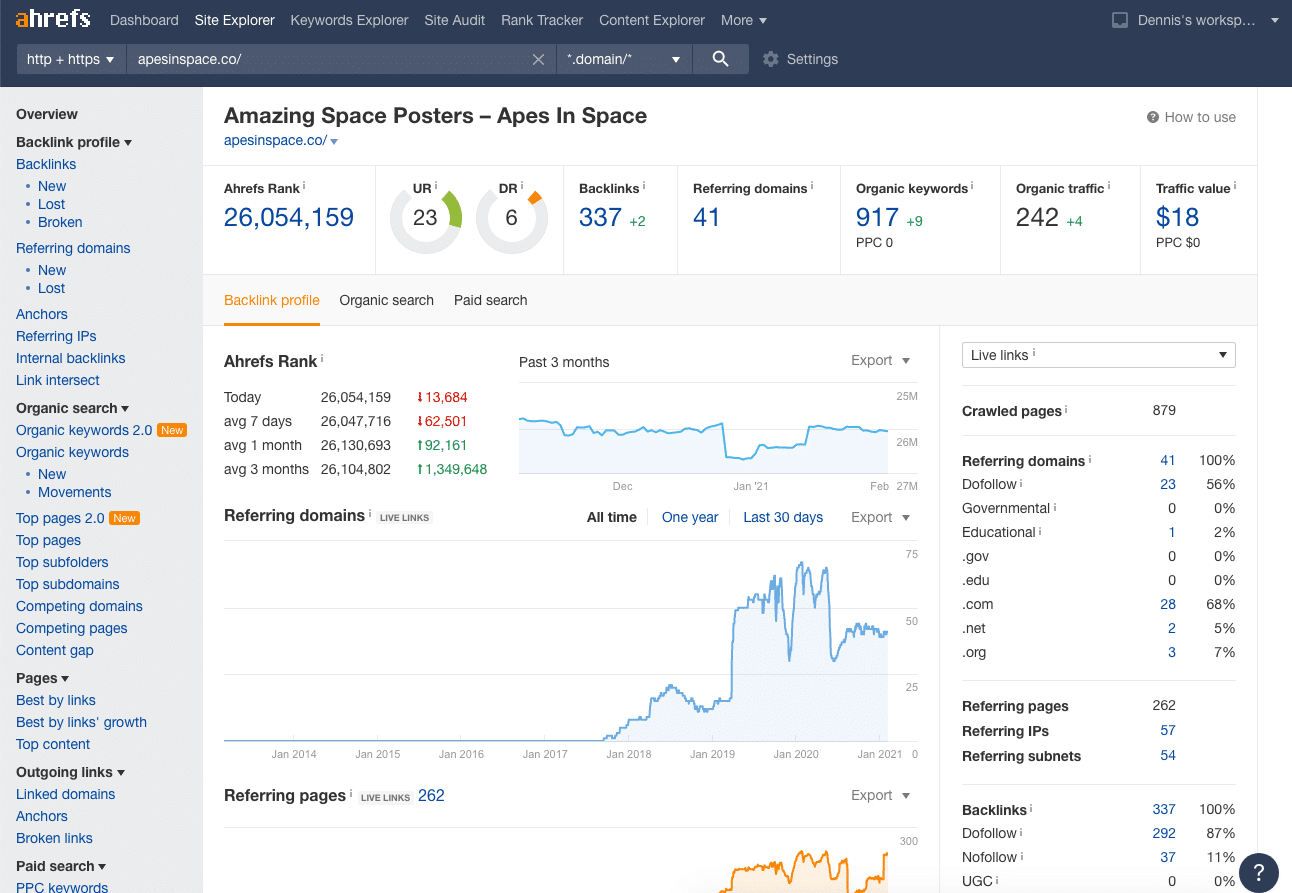
If you want to have the same combo of SEO and PPC, Spyfu is a cheaper alternative. But its interface feels very dated.
Should you become a Semrush customer?
If you’ve read this article and think Semrush could be useful, I suggest you sign up for a trial and take the tool for a spin.
If you’re offering SEO/PPC services for clients, having a tool like Semrush as part of your toolbox makes a lot of sense.
If you’re working for your own business, or can’t afford the price, consider signing up for a month, running all the reports, and then canceling again. That should give you a lot of insights to improve and grow your business a little further.
Use or have used Semrush? Let me know about your experience in the comments!
